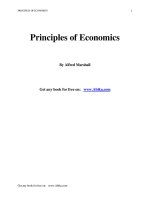Principles of economics openstax chapter15
Bạn đang xem bản rút gọn của tài liệu. Xem và tải ngay bản đầy đủ của tài liệu tại đây (572.34 KB, 37 trang )
LABOR MARKETS: UNIONS, DISCRIMINATION, AND
IMMIGRATION
DR. RICHARD GEARHART
ENTERPRISE COLLEGE
6/16/2016
LABOR SUPPLY AND DEMAND
EQUILIBRIUM
MINIMUM WAGE
MINIMUM WAGE
The neoclassical minimum wage leads to a SURPLUS of workers who want to work
at the new, higher, wage. This leads to MORE unemployment.
Some individuals “get off of the couch” now that the wage is higher.
Some individuals leave their jobs to acquire this new, higher paid, job.
The shortage is shown by the difference between qD and qS.
However, most estimates have found that the minimum wage does little to reduce employment
(or increase unemployment).
Most of the increase in unemployment is found in teen workers (those who typically work only part
time and will leave at the end of a given time frame, i.e., summer).
However, these have typically been for smaller increases in the minimum wage than the new
increases found in California.
Efficiency wages; firms may not reduce employment from the minimum wage because workers may
actually increase effort from working (fear of losing job and higher pay, less shirking, …).
How, then, does the minimum wage affect the economy?
Firms pass the cost increase on to the consumer in the form of higher prices.
Firms eat the cost increases and see reduced prices.
Firms don’t reduce employment, but change the composition of employment (more older workers,
fewer “transitory” workers, such as high schoolers or college-aged individuals).
Firms reduce non-wage benefits (health insurance, retirement, reduced price meals, gym
memberships, etc.).
Firms start investing more in technological innovation that will lead to long-term unemployment
(where it will be hard to see the link between the minimum wage and employment numbers).
LABOR MARKET DISCRIMINATION
Labor market discrimination is when different workers are paid differently, but not
based on education, skills, training, or length of experience on the job.
In other words, discrimination occurs when people are NOT paid based on workrelated factors.
Discrimination occurs when some trait, that is largely not a choice by the
individual, leads to lower pay (gender, race, sexual orientation, religion, …).
There are two types of discrimination.
Statistical discrimination: when you discriminate based on the population average.
Before you hire a worker, you do not know how productive they will be, or how good of a worker.
You therefore base your expectations on observable features of that worker.
While bad (this tends to prevent upward mobility by the “discriminated” groups), it is based on
objective facts.
How can I get an education, and raise the population average, if I cannot get the jobs that will pay
for the college education?
Example 1: why are women paid less than men?
The probability of a male getting pregnant is strictly 0.
The probability of a female getting pregnant may be 0, but could be positive.
At older ages, women are more likely to be in ill health than males (more hospitalizations, more
sick leaves, etc.).
Statistical discrimination would therefore say that, each year, the probability of a female
missing work is higher than the probability of a male missing work. Pay them less.
Example 2: in terms of a college education, non-Hispanic whites are more likely to have a
college education (29%) compared to both Hispanics (14%) and Blacks (17%).
Suppose that you hire a worker at age 18, and your benefits include a paid college education.
You would like this worker to achieve the college education by age 30.
Based on statistical discrimination, you would be less likely to hire the Hispanic or Black
individual, as they are less likely (ON AVERAGE) to achieve a college degree.
Biased Discrimination: discrimination that occurs because a particular individual does not
like some non-choice attribute of a worker.
I will not hire a female because I do not like women in the workforce.
I will not hire a Methodist because those religious beliefs are antithetical to mine.
THIS is the bad discrimination. This is not based on any belief OTHER than dislike/hatred.
Statistical discrimination is, at the very least, based on a set of objective facts.
With both types of discrimination, workers in the disadvantaged group will be hired ONLY if
they agree to be paid less.
Does discrimination pay in a competitive labor market.
Based on a seminal article by Gary Becker.
The only way that a discriminatory firm will hire workers they discriminate against is if they pay
the workers less.
HOWEVER, it is unlikely that all firms discriminate against these workers. They will therefore
earn higher wages elsewhere, and will leave.
Discriminatory firms therefore lose high productivity “minority” workers.
BUT, they lose more than this. “Minority” shoppers will not want to shop at this firm, so they
also lose business revenues.
A study of female lawyers found that 55% of the wage difference (between them and male
lawyers) was due to the fact that women had worked less (childbirth, childcare, …).
Childless women earn no more than women with children.
Thus, other 45% is largely biased discrimination.
“Are Emily and Brendan More Employable Than Lakisha and Jamal? …”
Sent out IDENTICAL resumes to firms. Only difference was the name.
White-sounding names received 1 call for every 10 resumes sent out. Black-sounding names
received 1 call for every 15 resumes.
White-sounding, high quality resumes, got more callbacks than white-sounding, low quality resumes.
Black-sounding, high quality resumes got no more callbacks than black-sounding, low quality
resumes.
Found in EVERY industry (even for federal contractors and large employers).
We have both statistical discrimination and biased discrimination.
ECONOMIC IMPACTS OF IMMIGRATION
Immigration is the movement of peoples between countries (and where these peoples are not
natives, nor do they possess citizenship).
What are the economic impacts of immigration?
Immigrants tend to lead to lower wages for natives that they compete, in the labor market, against.
Immigrants tend to lead to lower product prices for ALL natives.
Suppose that low skilled immigration happens (i.e., immigrants do not have a college
education). They likely compete directly against low skill natives (natives without a college
education).
•
The presence of immigration leads to more workers competing for jobs.
•
•
This lowers the wages paid to workers.
This COULD lead to lower wages for other native workers whose jobs are not being “replaced” by immigrants.
•
Unlikely that this effect is large. Can lower wage, low skill (no college education) workers replace high skill (college
education) workers?
Suppose that these low skill workers (both natives and immigrants) produce clothes.
Because of immigration, the cost of producing a piece of clothing falls as the wage falls. What
happens?
Immigrants are either high skilled or low skilled.
Reduces the prices of low-skill products (agriculture, maid and janitorial services,
telecommunications support, landscaping, …).
Relieves pressures on not enough high skill workers.
Healthcare professionals (doctors, nurses).
STEM researchers.
Information Technology (IT).
What does the evidence suggest?
Immigrants add (after taking into account native job losses, loss in tax revenue, increases in
welfare payments) $7 Billion to $25 Billion in GDP per year.
These benefits would increase by attracting more high skill immigrants (nearly $55 Billion).
Wage impacts of immigration on natives is small.
Natives move to other cities.
Immigrants tend to “cluster” in immigrant enclaves (large groupings of similar immigrant groups).
10% increase in # of immigrants leads to wages to fall by 3-4%.
140,000 more immigrants each year would lower average incomes from $35,000 per year to $34,000 per
year.
Most of the impacts of lower wages from immigration are new immigrants replacing older
(existing in the country) immigrants.
Most of the native immigrant impact (i.e., lower wages) is felt by natives who have less than a
high school diploma.
High school educated, college educated, and more than college educated natives have a minimal
impact of immigration.
10% more immigrants in an area lead to prices of low-skill services (maids, nannies,
landscapers, farmworkers) to decrease by 2%.
2,000 more immigrant workers in Bakersfield would lead to a $20/year decrease in the price of
landscaping services.









